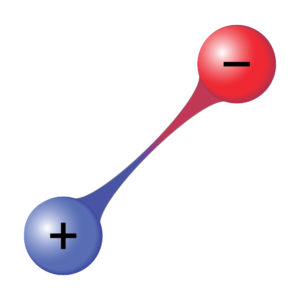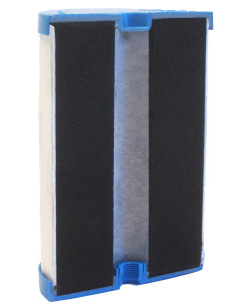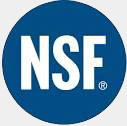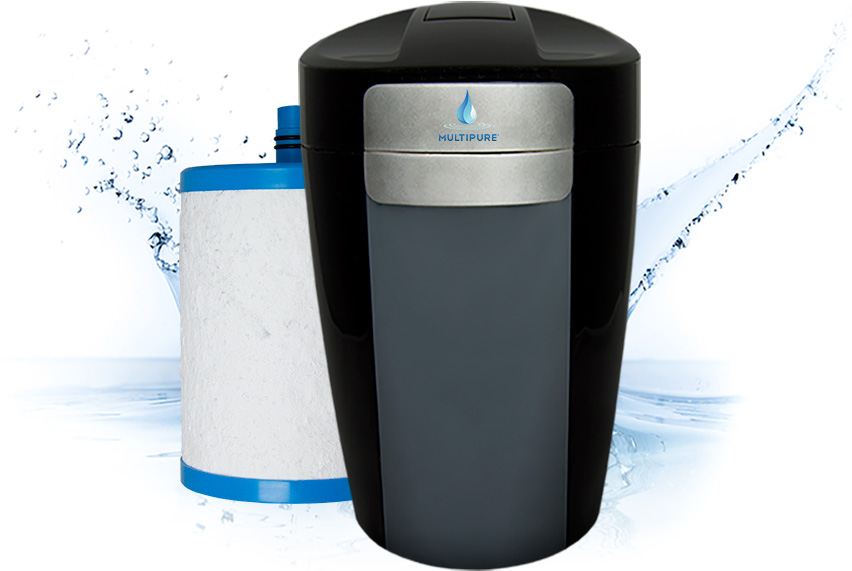Multipure Drinking Water Systems utilize a
innovative and proprietary PureBlock & Solid Carbon Block-based filter.
This filter employs multiple components and materials
to reduce the presence of more than 85 contaminants in water.



Mechanical Filtration
The water passes through a pre-filter that traps dirt, sand, and particles that affect the taste and overall appearance of the water. After passing through the pre-filter, the water then passes through the Solid Carbon Block, where particles as small as 0.5 microns are physically trapped by the filter. Asbestos, cysts, and particulates are reduced through mechanical filtration at the sub-micron level.
Electrokinetic Adsorption
The pre-filter acquires a positive molecular charge as water passes through it. Since most contaminants exhibit a negative charge in water, the filter fibers electrokinetically attract these negatively-charged particles onto the positively-charged filter surface. Generally, these particles are too small to be trapped by mechanical filtration.
Physiochemical Adsorption
The carbon block filter is a blend of selected activated carbons and other media that reduce aesthetic contaminants and health-related contaminants by adsorbing particles to its surface. Because the carbon block is densely compacted, it provides a longer contact time with the water, and thus, better performance than many other filtration technologies.
Why Solid Carbon Block?
Nationally recognized standards established for the drinking water treatment industry confirm that the most effective systems for the removal of both aesthetic and harmful contaminants are those that utilize Solid Carbon Block filters. Multipure is the original developer of Solid Carbon Block technology and has been the leader and innovator in the water treatment industry since 1970. Multipure, and its remarkable Solid Carbon Block filter, is synonymous with superior quality and exceptional innovation. With a Multipure Drinking Water System, you are guaranteed the best.


Contaminants mechanically filtered by the PureBlock* filter
- bacteria
- viruses
* Aqualuxe Only
Contaminants mechanically filtered by the Solid Carbon Block filter
• asbestos – mineral once used in building insulation; known to cause cancer
• cysts – dormant microorganisms that may include bacteria and parasites
• particulates – miscellaneous physical particles that can cause turbidity
(general water cloudiness)
Contaminants chemically adsorbed or reduced by the Solid Carbon Block filter
• chlordane – used as a pesticide
• lead and mercury – types of metals; known neurotoxins that can poison the blood,
nervous system, and brain
• MTBE (methyl tert-butyl ether) – used as a gasoline additive
• PCBs (polychlorinated biphenyls) – a fluid used in many electrical components
• Radon – a radioactive, colorless, odorless, tasteless gas
• toxaphene – a banned, highly toxic insecticide
• VOCs – volatile organic compounds
Contaminants reduced through chemical reaction
• chlorine and chloramine – chemicals often used as disinfectants
Detailed Contaminant Reduction List
Multipure® Drinking Water Systems are NSF certified, and tested according to NSF/ANSI Standards 42 (Aesthetics), 53 (Health Effects) and 401 for the reduction of:
• Arsenic V*
• Asbestos
• Atenolol**
• Bisphenol A**
• Carbamazepine**
• Chloramine
• Chlordane
• Chlorine
• Cyst (Giardia, Cryptosporidium, Entamoeba, Toxoplasma)
• DEET**
• Estrone**
• Ibuprofen**
• Lead
• Linuron**
• Meprobamate**
• Mercury
• Metolachlor**
• MTBE
• Naproxe**
• Nonyl phenol**
• Particulate matter, Class I (0.5 micron)
• PCB
• Phenytoin**
• Radon**
• TCEP**
• TCPP
• Toxaphene
• Trimethoprim
• Turbidity
• Volatile Organic Chemicals (listed below):
o Alachlor
o Atrazine
o Benzene
o Carbofuran
o Carbon Tetrachloride
o Chlorobenzene
o Chloropicrin
o 2,4-D (Dichlorophenoxyacetic acid)
o Dibromochloropropane
o o-Dichlorobenzene
o p-Dichlorobenzene
o 1,2-Dichloroethane
o 1,1-Dichloroethylene
o cis-1,2-dichloroethylene
o trans-1,2-dichloroethylene
o 1,2 Dichloropropane
o cis-1,3-Dichloropropylene
o Dinoseb
o Endrin
o Ethylbenzene
o Ethylene Dibromide (EDB)
o Haloacetonitriles (HAN):
- Bromochloroacetonitrile
- Dibromoacetonitrile
- Dichloroacetonitrile
- Trichloroacetonitrile
o Haloketones (HK):
- 1,1-dichloro-2-propanone
- 1,1,1-trichloro-2-propanone
o Heptachlor
o Heptachlor Epoxide
o Hexachlorobutadiene
o Hexachlorocyclopentadiene
o Lindane
o Methoxychlor
o Pentachlorophenol
o Simazine
o Styrene
o 1,1,2,2-Tetrachloroethane
o Tetrachloroethylene
o Toluene
o 2,4,5-TP (Silvex)
o Tribromoacetic acid
o 1,2,4-Trichlorobenzene
o 1,1,1-Trichloroethane
o 1,1,2-Trichloroethane
o Trichloroethylene
o Trihalomethanes (TTHM):
- Chloroform (surrogate chemical)
- Bromoform
- Bromodichloromethane
- Dibromochloromethane
o Xylenes (total)
*Multipure Aquaperform and Aqualuxe models are certified to reduce Arsenic V. Multipure Aquaversa and Aquadome models do not reduce Arsenic V; however, they reduce all other contaminants listed.
The list of contaminants that Multipure Drinking Water Systems reduce does not mean that these substances are present in your tap water. Be sure to check for compliance with state and local laws and regulations.
